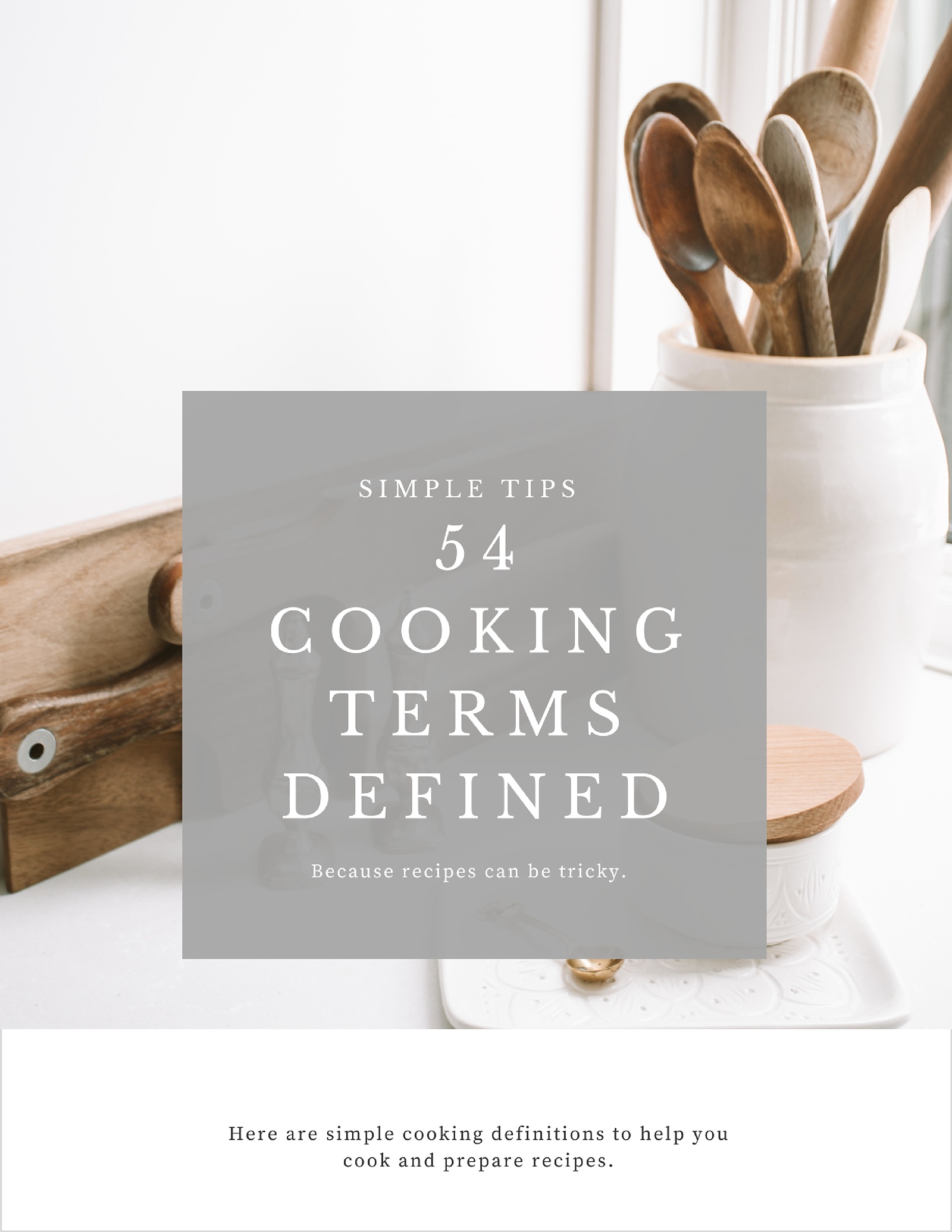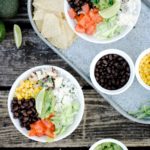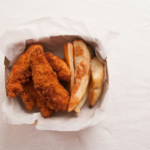
When you’re reading through a recipe, do you ever stop, scratch your head and ask, “What does that mean?” When I first ventured into the world of cooking, I often found myself a bit confused and, oftentimes, guessing on how to perform a certain task.
The more I cooked, the more I began to realize that cooking terms popped up everywhere in recipes. Thankfully, over time I’ve learned what they mean.
To beginners, and maybe even some veterans out there, a few cooking terms found in recipes might leave cooks a bit puzzled.
In an effort to lessen the confusion, I’ve compiled a list of basic cooking terms that you should be familiar with when you scope out and begin to tackle new recipes.
Basic Cooking Terms Defined
Al dente: Italian term to describe pasta and rice that are cooked until tender but still firm to the bite
Bain-marie: A pan of water that is used to help mixtures, such as custards, bake evenly and to protect them from the direct heat of the oven or stove
Bake: To cook in the oven – the terms baking and roasting are often used interchangeably, but roasting involves cooking at a higher temperature (at least in the beginning) to brown the surface of the food
Baste: To spoon, ladle or moisten with a filled baster hot cooking liquid over food at intervals during cooking to moisten and flavor the food
Beat: To make a mixture smooth with rapid and regular motions using a spatula, wire whisk or electric mixer; to make a mixture light and smooth by enclosing air
Bind: To add egg or a thick sauce to hold ingredients together when they are cooked
Blanch: To plunge some foods into boiling water for less than a minute and then immediately plunge into iced water – this is often used to brighten the color of some vegetables; to remove skin from tomatoes and nuts; or performed to halt deterioration prior to freezing
Blend: To mix two ore more ingredients thoroughly together; not to be confused with blending in an electric blender
Boil: To cook in a liquid brought to a boiling point and kept there
Braise: To cook in a small amount of liquid (also called stewing or pot roasting); not to be confused with poaching, in which the food is completely submerged in simmering liquid; braised dishes use a small amount of liquid
Bread: To coat foods to be sauteed or deep-fried with flour or a breadcrumb mixture to create a crust
Broil: To cook with a direct heat source, usually a gas flame or an electric coil above the hood
Clarify: To make a liquid clear by removing sediments and impurities; to melt far and remove any sediment
Corned: To salt and cure a meat
Coat: To dust or roll food items in flour to cover the surface before the food is cooked; also, to coat in flour, egg and breadcrumbs
Cream: To make creamy and fluffy by working the mixture with the back of a wooden spoon; usually refers to creaming butter or margarine with sugar (can also be done with an electric mixer)
Cube: To cut uniformly into small pieces with six even sides (e.g., cube of meat)
Deglaze: To dissolve dried-out cooking juices left on the base and sides of a roasting dish or frying pan; add a little water, wine, or stock, or stock and scrape and stir over heat until dissolved (resulting liquid is used to make a gravy or added to a sauce or casserole for additional full-bodied flavor)
Degrease: To skim fat from the surface of cooking liquids (e.g., stocks, soups, casseroles, sauces)
Dice: To cut food into tiny cubes (1/8 to 1/4 inch)
Dilute: To reduce a mixture’s strength by adding liquid (usually water)
Dollop: A small gob of soft food, such as whipped cream
Dredge: To heavily coat with icing sugar, flour or corn flour
Drizzle: To pour in a fine, thread-like stream moving over a surface
Dust: Lightly coating a food with a powdery substance, such as flour or powdered sugar
Egg wash: Beaten egg with milk or water used to brush over pastry, bread dough or biscuits to give a sheen and golden-brown color
Flake: To separate cooked fish into flakes, removing bones and skin, using two forks
Fold in: To combine a light, whisked or creamed mixture with other ingredients – this is accomplished by adding a portion of the other ingredients at a time and mix using a gentle circular motion, over and under the mixture so that air will not be lost (it’s always best to use a spatula)
Fry: To cook a food in a hot fat
Glaze: To brush or coat food with a liquid that will give the finished product a glossy or shiny appearance, and on baked products, a golden-brown color
Grind: To pass meats or nuts through a grinder or a food processor to reduce to small pieces
Infuse: To steep food in a liquid until the liquid absorbs the flavor
Julienne: To slice food (e.g., vegetables and processed meats) into fine strips the approximate length of matchsticks
Knead: To work a yeast dough in a pressing, stretching and folding motion with the heel of the hand until it is smooth and elastic so as to develop the gluten strands
Macerate: To soften fruit in a syrup, liqueur or spirit to give added flavor
Marinate: To combine foods, usually meat or fish, with aromatic ingredients for some time to tenderize and add flavor
Mask: To evenly cover cooked food portions with sauce, mayonnaise or savory jelly
Pan-fry: To fry foods in a small amount of fat or oil, sufficient to coat the base of the pan
Pare: To peel the skim from vegetables and fruit
Pinch: The amount of dry ingredients you can hold in a pinch (between your thumb and forefinger). It’s equivalent to 1/16 teaspoon
Poach: To simmer gently in enough hot liquid to almost cover the food so shape will be retained
Puree: To work or strain foods until they are completely smooth
Saute: To cook over high heat on the stove in a small amount of fat in a saute pan or skillet
Scald: To heat milk just below the boiling point (or, to immerse a vegetable or fruit in boiling water in order to remove its skin easily)
Sear: To brown the surface of pieces of meats and/or fish by submitting them to intense initial heat
Simmer: To cook in liquid just below the boiling point (approximately 205 degrees F), with small bubbles rising gently to the surface
Skim: To remove fat or froth from the surface of simmering food
Stew: To cook in a manner similar to braising, but generally involving smaller pieces of meat, and therefore, a shorter cooking time
Stir-fry: To quickly fry small pieces of food in a large pan over very high heat while stirring
Stock: The naturally flavorful liquid produced when meat, poultry, fish or vegetables have been simmered in water to extract the flavor
Sweat: To cook sliced onions or vegetables in a small amount of butter in a covered pan over low heat to soften them and release flavor without browning
Whip: To beat a preparation with the goal of introducing air into it; also, the balloon-shaped wire whisk often used to do so
Whisk: A utensil with looped wires in the shape of a teardrop, used for whipping ingredients like batters, sauces, eggs and creams (the whisk helps air get into the batter)
Zester: A utensil with tiny cutting holes on one end that creates threadlike strips of peel when pulled over the surface of a lemon lime or orange (it removes only the colored outer portion of the peel)
What are some terms that have stopped you in your tracks when preparing a recipe?






i have a recipe for a custard type of cream and at the end of the recipe it says to strain and then place in the fridge…do i actually pour it through like a pasta strainer? I have never heard of this before!
The recipe calls for something finer, like a chinois or cheese cloth.
I would like to know what is meant by a few hours. I know a couple is 2 but a few can be 3 or more. I'm marinating a piece of beef.
A "few" hours generally means at least 3, but up to 5 or 6 hrs. For marinating beef, you can even marinate over night, it's not going to hurt it, it'll make it taste even better! Just my thoughts!
I have a receipe that says "butter size of egg". This is for orange icing. What does this means????? Thanks
Anonymous: "Butter the size of an egg" usually means approximately four tablespoons.
Once I had marinated the beef and forgot to process it. Since then I have never tried it again
what does one quarter mean it asks for one quarter teaspoon of salt? is that 1/4?
What does low heat mean in cooking
i am in need of knwoing what the term in baking of 'alousie is. something to do with a piping bag and making into a 'alousie?
Thank you for the explanation
I have an old English recipe book that in a recipe for pastry calls for 'cooking fat'. What is this? It is not butter as the recipe includes that too. Also what is 'castor sugar'? English cooking terminology seems to differ quite a bit.
I think that cooking fat would refer to lard, like crisco. Caster sugar is a very fine sugar, finer than granulated but not like confectioners sugar, which is more powdery. Caster sugar can be found in some grocery stores, but I live in a very small town so I buy it online from Amazon. It’s a bit expensive that way but I don’t use it that often, so it lasts a long time.
castor sugar (brits) goes under the name of superfine sugar in the US
If recipe says bake cookies 10 min then turn…. does that mean flip cookies over?
What type of a cookie recipe is it? It could mean flip the cookies or turn the cookie sheet. But, I would love to know what cookies you’re trying to make. Thanks!
Hi what does butter &flour metal rings for a recipe before you but the mixture in
What type of recipe is it? Usually, when using metal cookie cutters for cookies, you should flour the cookie cutters so that the dough doesn’t stick to the cookie cutters. That’s just an example. But, I would love to have a recipe reference to help you. Thanks!
What does # mean? I am very confused and it is after a number. I am guessing it means some kind of measurement but what kind?
The # symbol usually stands for pound.
Pounds or number for us over 50
I found a phrase that confused me. Do you know how to “beat the butter until the salt is out”?
I have a recipe that lists 2 pHs eggs. What does that mean?
What does “Recipe to Attach” designate. An alternative to primary one?
After many s3arches, I am still unable to define “tap it”.
My recipe says:
Boil the water, mix in the cinnamon, “TAP IT” and let it cool before adding the honey.
Does TAP IT mean to literally tap the glass after you stir it…. or perhaps to carefully pour off the cinnamon water to separate from the slimey slush at the bottom?
What does do. mean in a recipe. I found it in a recipe for cupcakes. An old recipe from the American Cookery – Amelia Simmons. 1796?
Any idea, anybody?
The word [ glass ] is writ ten just like this next beside do.. Does it mean glass. I am so troubled, puzzled, stuck, and confuzzled.
Thanks for any body’s time! :)
What does emptiness also mean? I found it in the same recipe. Just wondering!
Thanks
No sorry I meant emptins.
What does currant and rubbed into mean
Please I need to know pronto, ASAP, very soon, like now.
Thank you very much for your time :)
What does it mean to “remove tenders” in a chicken recipe?
What does cook only one at a time mean its a frozen chicken and vegetables meal?
Sorry I have a ? I just found your site . What she mean she says one half cup of corn syrup .does she mean a 1/2 cup or one cup and a 1/2cup. Thank you for your time.
What does cool slightly mean? I am adding eggs after the caramel cools slightly. How long would I wait
what dose 24/4 cup mean
What does the phrase “liquid to taste mean? Exactly how much liquid do you put in the recipe? It is a recipe for a protein shake.
Help my receipe calls for macaroni noodles what is that ? I’ve used all kind of pasta noodles that’s a new one for me-) on 82 young thank you barbaragrizzy1111@gmail.com
I know this was awhile ago now but I’m from the Philadelphia area and some Italiansive known call pasta, macaroni. So it’s possible it means any type that you like. I personally only call elbows macaroni but to each his own.
Hi. I’m going to make corned beef and cabbage. I’ve made it before but I’m wondering about when it says “add water just to cover the meat” if I’ve been doing this right. Where do you bring it up to? Just to cover the bottom? Or middle? Or to the top? but not over?
Thanks
Please what is the meaning of cuddle in baking
I have a recipe that’s over 100 yrs. old for Egg Nog…
It say to pour into bottles and store in cool place until it mellows… Can some tell me what that means ? I know I’m to put in fridge and chill in this day and age.
I was making a sausage and it said “brown” for two minutes what does that mean?
If it is ground sausage, cook the sausage until it is no longer pink. The key is to maintain a constant source of heat and to turn the meat frequently to prevent burning. If it is a sausage link, then place the sausages links on a grill or skillet on medium-high heat (NOTE: If you are cooking thick sausages, then poach the sausages in water for 5 to 10 minutes and then add to the grill or pan). Place the sausages away from direct heat if you are grilling them and cover the grill. Turn the sausage as needed with tongs to allow the sausage to brown without burning.
what does spoon- tender mean?
Spoon tender usually means it can be cut with a spoon.
what does it mean by “let stand” I am cooking something in the oven, does it mean turn off the oven and leave it there or does it mean take out and let is stand
Hello,I log on to your new stuff named “What Does That Mean?! Cooking Terms Defined – How To: Simplify” on a regular basis.Your writing style is awesome, keep doing what you’re doing! And you can look our website about proxy.
when cooking prime rib, what does the term “plave” mean?
I have an old recipe for Lambs head and it calls for adding the “lights” to the gravy….what part of the lamb is the “lights?”
what does (simplify) in a recipe mean in making frosting